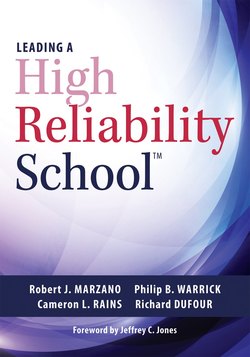Читать книгу Leading a High Reliability School - Richard DuFour - Страница 8
ОглавлениеForeword
By Jeffrey C. Jones
Student achievement—this is by far the main purpose of a school. Yet with the rising tide of standardized testing and the numerous demands placed on schools, educators often find themselves straying from this main objective. From daily paperwork to lesson plans and assessment, educators are bombarded with things to do besides focus on learning, and seemingly not enough time to do them. So, how can educators sort through the myriad tasks, both required and optional, to focus on the essential things they need to do to promote student achievement? In other words, how can they determine that the work they’re doing is the right work?
In Leading a High Reliability School, my friends and authors Bob Marzano, Phil Warrick, and Cameron Rains provide a comprehensive model that leaders can follow to ensure the right work is being done. Grounded in years of research, the high reliability school (HRS) model encompasses twenty-five variables, or leading indicators, that leaders can implement. Ranging from a safe school environment to a guaranteed and viable curriculum for all, these leading indicators provide a road map for leaders to follow.
In the clear and compelling introduction crafted just prior to losing his battle with cancer, our dear friend and colleague Dr. Rick DuFour writes about the powerful impact of professional learning community (PLC) work, specifically the PLC at Work™ process and its integral role in creating high reliability schools. A pioneer in PLCs and a Solution Tree author for more than twenty years, Rick brought his decades of experience and insight to this work.
In the remaining chapters, Bob, Phil, and Cameron detail the work surrounding each of the twenty-five leading indicators of a high reliability school. With a wealth of examples, rubrics, learning progressions, and tables, they walk the reader through the process of implementing each indicator, obtaining data for continuous improvement, and ensuring leader accountability. Each chapter concludes with evidence from the field—anecdotes from school leaders about their experiences, challenges, and successes in implementing the HRS model.
The work of schools isn’t easy. It involves asking hard questions, prioritizing the work, collaborating, analyzing data, and monitoring progress. The list goes on and on. In Leading a High Reliability School, leaders will find a comprehensive model that enables them to approach the work with clarity of purpose and clear direction. And at Solution Tree and Marzano Research, we consider it a great honor to bring this work to you.
